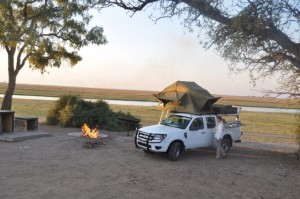


Classic Drives –African Self Drive Safari
A self drive safari is the ultimate ambition of many drivers abroad. The chance to be up close and personal with the ‘Big 5’ in a sometimes hostile and always alien environment, and without the constraints of a guided safari tour are a big draw for travellers to Africa.
I’ve undertaken self drive safaris in a number of African countries, and there can be big variations in the standard of roads, accommodation and general driving experience.Therefore an element of planning is essential.
Planning
First you need to decide whether self drive is for you, or whether you’re going to go for a fully guided safari experience with a driver. The benefits of having a guide are really around that person’s experience and knowledge of the bush and the specific area they’re operating in. I’ve had really good guides who can spot a concealed animal from a long distance. To such an extent that I’ve still be unable to see it even when they’re giving me directions to spot it! They can also provide you with a lot of detail on the flora and fauna and pass on some interesting anecdotes, and many will be in radio contact with other guides so can be updated on where particular wildlife has been spotted. I have however, had a rather poor guide, who failed to spot anything I hadn’t already seen and who drove at a ridiculously slow pace,even on a public road on the approach to the National Park.
The drawbacks of a guided safari are that you’re obviously only going to go where the guide takes you, for how long they want and at what time. If you’re in a lodge you’ll probably go for a morning and sunset drive and will be left to amuse yourself at the lodge in between. Also, you’ll probably have to share the vehicle with other tourists and that can be a big determining factor in how enjoyable your trip is.
I’ll therefore assume you opt for the self drive option…
The first thing to do is plenty of research on the particular area you’ll be visiting. You need to do that before you even consider renting a vehicle as requirements can vary greatly between countries and even between National Parks within countries. For instance, I drove Etosha National Park in Namibia in a 2WD VW Polo and that was quite adequate. Try that in somewhere like Chobe NP in Botswana and you won’t move very far!
Therefore read plenty before you begin to make reservations. Bear in mind that conditions will vary a lot between wet and dry seasons too. I usually start my research via a guide book such as the Lonely Planet, though you may find info on Self drive is a little sparse. I then check out forums such as Trip Advisor which tend to be better for safari info than more backpacker focused sites such as LP Thorn Tree. There are also some good independent sites providing advice on most safari areas in Africa.
Once you’ve determined what the conditions will be like you can then begin to look for a vehicle. The countries pages on DriverAbroad.com provide info on local companies and in my experience if you’re looking for a camper or rooftent vehicle you’ll probably have more options with a local firm than with one of the big multinationals.
Make sure you understand the full terms of the rental agreement. In some countries, Zambia being one, the actual rental is quite cheap but you often find a per KM charge on top of that which can make the overall cost high.
Also make sure you fully understand the insurance- you’ll probably be driving in rough terrain so the chance of minor damage is high. Also make sure any camping equipment is going to be covered. You may also find that international excess insurance policies don’t cover 4WD vehicles driven off paved roads.
Using a local company also gives you opportunities to ask questions about the likely driving conditions and get some guidance on the type of vehicle you’ll need, driving times and distances and even the chances of seeing wildlife at the time of year you’re visiting.
Also don’t discount the possibility of renting in one country and taking the vehicle across borders to another country. It may work out cheaper, even with a cross border charge. I found this to be the case for Botswana when I rented the vehicle in Zambia. I also know drivers who have had vehicles delivered to Maun in Botswana from Jo’burg. They felt that the quality of vehicles were better value for the price in South Africa than Botswana.
Cross Border info for Southern Africa countries can be found here-
https://www.aa.co.za/cross-border-information
Once you’ve made your booking and agreed terms, make sure you have all the detail on email to avoid complications when you arrive to pick up the vehicle.
If you are a local rental company offering safari-ready self drive vehicles and would like to feature on DriverAbroad.com please check details on our Partnering page or contact us on ADriverAbroad@Outlook.com
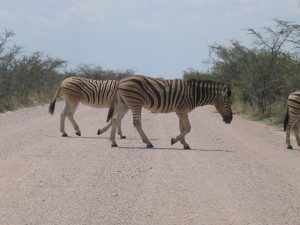
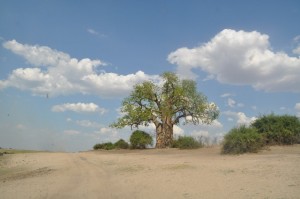

Collecting the Vehicle
The first thing to bear in mind is that picking up a camper or rooftent vehicle is going to take a lot longer than collecting a normal rental car. There will need to be some instruction, especially if this will be your first experience of using such a vehicle. There will also usually be a thorough inventory check of all the camping apparatus. In my experience, you should assign 3 hours to the handover process in your planning, if it’s your first experience of using the vehicle.
If you haven’t driven a 4WD vehicle before, get the rental company clerk to run through the basics with you.There may also be some semi-technical hints and tips to take in. One important one is to learn how the air compressor works if there is an inbuilt one. That’s important for re-inflating your tyres to drive on a paved road if you have to let some air out to drive in sand or mud.
Also, if you don’t have your own GPS navigational device, it’s worth asking the rental company if they can rent one to you if you’re going to be driving in an area with few sign posted roads or easily navigable landmarks eg Chobe NP.
Safari Self Driving
As stated above, road conditions will vary depending on the area you’re visiting. In some National Parks all the roads are paved and well signposted. In others, roads will be deep sand or mud with few signposts.
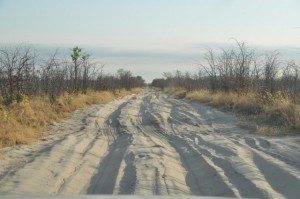
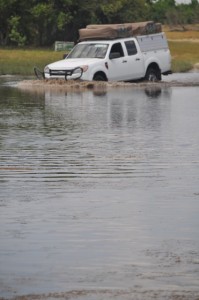
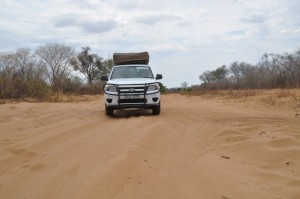
Driving in Sand – The first thing to do when driving in sand is to reduce your tyre pressure (though ensure you have a tyre gauge and a means to reinflate the tyre when you’re back on tarmac.) This increases the ‘footprint’ of your tyre thus giving more purchase in the sand. The optimum tyre pressure will vary by vehicle and the rental company should be able to advise on this.
If you forget to ask them a good way of estimating how much air to let out is to park the vehicle on the flat. Place a stone around 0.75cm from the outer edge of your tyre, then let the air out until the edge of the tyre touches the stone.
Driving in sand should be done in Low range of 4WD. Follow existing tracks and try to maintain a steady speed, in 2nd or 3rd gear, avoiding heavy braking or accelerating. Try and coast to a halt if possible with the clutch depressed. Try and have your wheels pointing forward and downhill if possible when setting off. When turning on sand try and make as wide a turning arc as possible. If you encounter a steep hill approach it with the wheels as straight as possible.
If you do get stuck in deep sand, avoid the temptation to press the gas and accelerate out as this will just make you more stuck. Slowly try to reverse and if this works, try edging forward again slowly.If this doesn’t work you may need to deflate your tyres more. Do this gradually. Most tyres can be deflated to a minimum of 40 kPa (6psi) but this should be avoided unless absolutely necessary. Ensure the underside of the vehicle is clear of the sand before attempting to free yourself.
Also, a companion should be keeping watch for animals while you’re working to free the vehicle . If you’re still unable to free yourself you may need to resort to a jack which most 4WD vehicles should be equipped with and the rental company hopefully made you aware of. If still stuck, you will need to wait for help to arrive. Don’t ever set off walking to find assistance.
An example of driving on deep, rutted sand can be found on my YouTube site.
Driving on gravel roads is usually not as taxing as driving on sand, but will still be more challenging than tarmac. The first and obvious point is to reduce your speed -60-70KMH is probably the optimum speed for most roads though gravel can conceal pot holes so if you’re worried about the road quality, you should slow right down. Keep your hands on the wheel at all times and, as with sand driving, avoid heavy braking and accelerating. If it’s dusty, put on your lights and keep a safe distance from any other vehicles. As you’re travelling faster than on a sand road, be particularly aware of animals which can panic and run into the road. This is particularly true at night when driving on gravel roads becomes much more hazardous. In most cases you probably won’t need to engage 4WD on gravel roads.

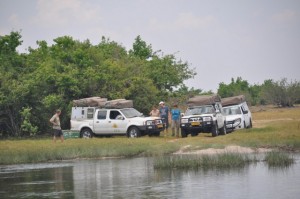
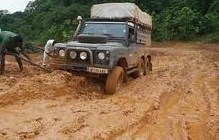
Crossing rivers may be necessary and this can be an unnerving experience but needn’t be with some forward planning. Never attempt to cross a river in a non 4WD vehicle. You should also be aware of the type of 4WD you’re driving. You need to understand where the air intake is located as this is a direct route for water to enter the engine. A 4WD fitted with a ‘snorkel’ enables the air intake to be lifted above the engine and therefore above the water line. If your vehicle isn’t fitted with a snorkel care must be taken to never submerge the air intake. Drawing water into the air intake will result in the engine cutting out and possible serious mechanical damage. Most 4WD vehicle manufacturers will advise of the safe water line in the owner’s manual (its usually around 50 cm) so check this if unsure.
The first rule of driving across rivers is never to rush into it. Stop and take stock of the situation- ask locals for advice if any are present, but don’t rely on what they tell you. They may not be able to drive themselves, so could be unqualified to give advice. If other vehicles are crossing, observe the route they take and try and replicate that.
If no one is around you will probably need to walk the crossing first. Use a wading stick to check the depth as you proceed- also be on guard for crocodiles and hippos. If the river is flowing so strongly that you lose your footing, it will be too dangerous to cross in a vehicle.If the river can’t be waded accept that it can’t be driven either. The time taken to wade the river also gives the vehicle time to cool down – Plunging hot metal into cold water is a likely cause of various mechanical failures.
Do not cross at deltas where rivers empty into a lake as they are likely to be clogged with mud and will generally be wider than other parts of the river.
As you walk the river, remove any large concealed stones that you come across. If the route across the river will require deviations from a straight line, mark the points you need to turn with sticks driven into the river bottom. If there are no sticks available, use plastic bottles or bags tied to a rock with string.
Avoid steep entry and exit points and check that the bank will support the weight of the vehicle.
If you fear that you may get stuck and will need to be pulled out by a support vehicle , attach a rope or winch line to the vehicle before you drive into the river. Attaching a recovery line to an already submerged vehicle can be difficult.
Before setting off, remove seat belts and wind down windows to enable a speedy escape if you get stuck.Engage 4WD Low and 1st or 2nd gear and try and maintain a steady speed, avoiding any heavy acceleration. You should never change gear when crossing a river as water could get into the clutch mechanism, so 2nd gear is probably a good option to help you maintain enough sped to generate a bow wave which helps push water away from the engine. If you aren’t generating a bow wave you’re driving to slowly, if the wave goes over the bonnet and hits the windscreen you’re driving too fast.
If the vehicle stalls you should put it into neutral without using the clutch and try and restart. If successful you will have to risk using the clutch to engage 1st gear but there is a risk of water getting between the clutch plates and flywheel. If the vehicle doesn’t restart, your best bet is probably going to be to exit the vehicle and wait for help. If the river is fast flowing, get out on the side of the car facing away from the flow to avoid being pulled under the vehicle.
Be aware when driving on deep water that your vehicle will become partially buoyant and this can cause problems exiting via a steep or slippery bank. I’ve had experience of this and it can be difficult to judge the correct approach angle so care should be taken when exiting the river.
Once on dry land you should perform a check to ensure the vehicle is performing properly before you proceed.
Driving in Mud In the rainy season in places like Chobe you’re going to have to negotiate some serious mud! As with driving in sand, with deep mud its worth letting some air out of the tyres to increase the footprint on the road.
If you can stop and plan how to negotiate a section you should do so. You may need to get your boots dirty by walking the route. Try and select the highest set of tyre tracks to follow, as the water will gather more in the lower tracks.Be careful not to follow a deep track set by a vehicle with higher clearance than yours which risks leaving you stranded on the central ‘stripe’.
When driving, maintaining momentum is the key as is listening to the engine. Select 4L and 2nd or 3rd gear . Avoid heavy acceleration but change the amount of gas in line with what the engine is telling you. Try and keep a steady speed to avoid getting stuck. ‘See sawing’ the steering wheel slightly can help the tyres keep moving and avoid getting stuck. If your wheels are spinning, step off the gas lightly. If you get stuck, try reversing before you try to move forward again. If you do get stuck, you’ll need to wait for assistance. At the end of the day, you’ll have a good story and some great mud spattered pictures!
There are a few good ‘driving in mud’ clips on YouTube.


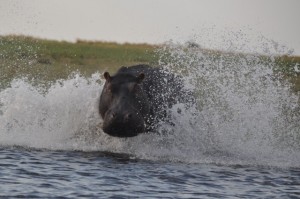
Spotting the Wildlife
The first and obvious point when driving in a game park is to stay in your vehicle. Even stopping for a toilet break can be dangerous unless you can see all of the terrain around you and there’s no long grass, bushes , rocks etc which could conceal a predator. If you must get out, to mend a puncture or remove a rock from the road for instance, a companion should be positioned in the best position to keep watch- probably on the roof is best.
Don’t stand up with your head out of the sun roof or wave anything out of the vehicle when driving. In many game parks, animals will be used to seeing vehicles but anything out of the ordinary could alarm them.
Drive slowly- around 30 KMH is probably a good speed. This will give you a much better chance of spotting animals. Look around, scan the bush from side to side. Look at the middle distance rather than the immediate area by the road. Pay particular attention to shady areas. Look for shapes or colours that stand out, or look for movement.
Always beware of animals in the road. Antelopes may panic and jump in front of you. Elephants and buffalos will wander into the road without fear of vehicles.
Keep your windows up. Baboons will enter vehicles at any opportunity. Also animals can smell food through open windows which will attract them to your car.
Early morning and late afternoon are usually the best time to see animals, though leopards hunt during the day so can be seen anytime.
Stop at waterholes and wait a while, especially in the dry season. Animals often come down to the water to drink, so sometimes it pays off to sit quietly and wait at a waterhole.
Something you’re highly likely to experience on a self drive safari is elephants in the road. Faced with an elephant, or a herd, coming towards you on a narrow track can be a scary, but thrilling experience. For a safari novice, it’s also more difficult to gauge the animals’ mood. The most dangerous potential is from a bull elephant in musth. (derived from the Persian word mast, meaning intoxicated, and sometimes spelt Must or even Musk) This is a huge surge in testosterone levels which can make the beast aggressive and unpredictable and is experienced only by older bulls aged from around 25.
Signs that a bull elephant is in Musth are the discharge of a tar-like secretion called temporin from the temporal ducts on the sides of the head which is easily visible. The elephant will massage these ducts on trees and other obstacles. There may also be a constant trickle of urine with accompanying strong smell. He will waft his ears often and spread them when walking. If approached by a musth bull elephant you should take evasive action. Reverse if required in order to get out of his way. Most attacks on vehicles are carried out by musth bulls.
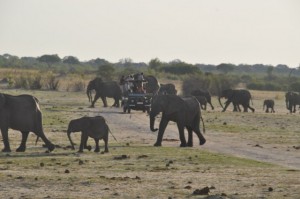

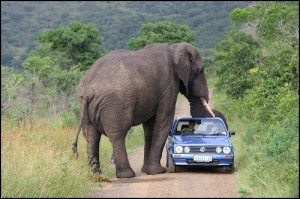
I have personally had a few encounters with elephants and have sought advice on the best way to react when faced with them on the road. There is some differing advice on whether the engine should be left running or not but the consensus seems to be –
Elephants by the roadside eating:
Approach quietly and slowly, and keep as far away as the road will allow. If their behaviour changes, i.e they stop eating for more than 1 minute, then move away. If they continue eating, they have considered you a non-threat.
Elephants crossing the road:
Stop a safe distance away, making sure that you are not in their line of direction, especially if they are in a herd with babies. Wait for them to finish crossing, then continue on slowly.
Elephants approaching towards you:
Stop the car as soon as you see elephants approaching. Its better to let them approach you than to drive close to them.
Turn off the engine, but if you have time to manouvere, position the car in the best position to drive away if you need to.
Allow the elephants to approach but keep a very close watch on the situation. Bull elephants should be checked for signs of Musth as mentioned above. Mothers with babies should be monitored closely. If they begin to flap their ears or move more quickly it may be time to get out.
See my Youtube site for an example of how not to try and pass oncoming elephants.
And an example of when even the professionals get it wrong –
Other Self Drive Safari Hints –
Many National Parks forbid collecting firewood and a night time fire is essential for light, warmth and to deter animals. Whilst approaching the park, keep an eye out for firewood and collect it as you go.
Beware of baboons. They often congregate at camp sites and will need no invitation to steal anything not locked up.
If in a tent, make sure food is locked in a secure airtight container if you don’t want nocturnal wildlife visits to your tent.
A self drive safari can be a leisurely drive on good roads or a challenging adventure in the wild, depending on where you go and when. Its always a fantastic experience though in my opinion and one of the true classic roadtrip adventures!
Although I try and keep the information in the site updated as much as possible, in a rapidly moving world, situations can change daily. Therefore please use the site as an approximate guide, and in conjunction with other resources in order to form your view on driving conditions, roads, safety etc.
